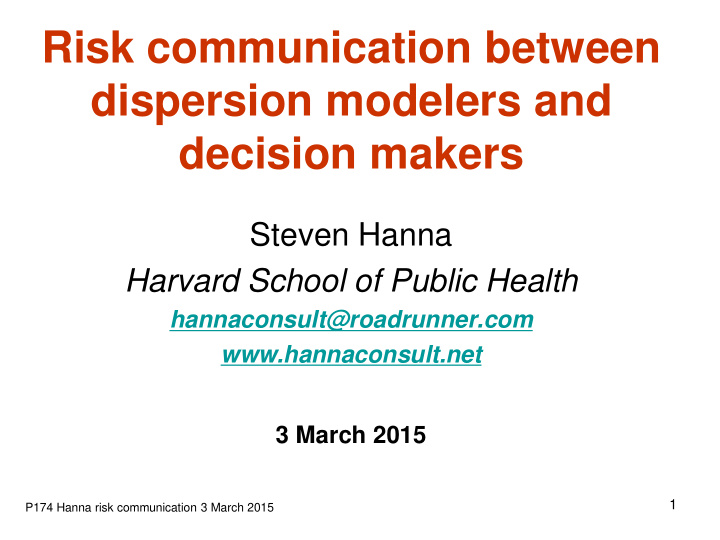



Risk communication between dispersion modelers and decision makers Steven Hanna Harvard School of Public Health hannaconsult@roadrunner.com www.hannaconsult.net 3 March 2015 1 P174 Hanna risk communication 3 March 2015
Model developers • Universities • National labs • Private industry • “Subject Matter Experts” – with advanced degrees in sciences, engineering, math, statistics, etc. • Little formal training in communications or risk assessment 2
Decision-Makers • Emergency responders • Planners • Mayor, governor, or other head of a government agency • Stakeholders such as railroads, chemical plant owners • Unlikely to have scientific training 3
Fitness-for-purpose • This is a term that is now widely used • Is the model “fit” for the specific scenario and decision process • Models are generally “fit” primarily for the scenarios with field experiment data used in their evaluations • Thus a dense gas release in a city on a steep hill is a tough modeling problem (no field data) 4
Situational Awareness • Not all modelers and models are the same • Not all decision makers are the same • Not all modeling scenarios are the same • Therefore all parties should communicate beforehand so that “everybody is happy” (or at least fully aware of the situation) 5
What model outputs are needed by decision-makers? • Concentrations or deposition for specific averaging times? • Dose (concentration integrated over time)? • Contour plots overlain on map? • Distance to a defined concentration limit • Etc. (Should be well-defined before the modeling starts) • This step needs communications between modelers and decision makers 6
What are the models able to do? • Decision-makers may have unrealistic expectations – They may want A, B, and C, and the model can produce only D.E, and F. • For example, non-modelers often think that the models can do more than is the case and are more accurate. • Again, there is a need for communications between modelers and decision makers 7
Common Theme • Most of the above slides include the words “communicate” • Modelers and decision-makers should hold workshops and communicate, so they have “situational awareness” and model outputs can be provided that are “fit -for purpose” 8
Recommend
More recommend